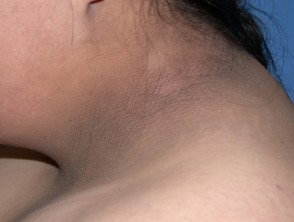
By Connie Colbert
Director, Canyon Health and Wellness Clinic
Acanthosis nigricans is a condition that causes a dark discoloration or hyperpigmentation and thickening of the skin in body folds and creases. It typically affects the armpits, groin and neck.

Acanthosis nigricans is not a skin disease but an outward sign of a potential underlying condition or disease.
It can affect otherwise healthy people, or it can be associated with certain medical conditions.
Sometimes acanthosis nigricans is something a person is born with (congenital). Most people with acanthosis nigricans have an insulin level that is higher than that of people of the same weight who do not have acanthosis nigricans.
Acanthosis nigricans is seen in both men and women. It is most common in those who are overweight, have darker skin and have diabetes or prediabetic conditions. Children who develop acanthosis nigricans are at a higher risk of developing Type 2 Diabetes later in life.
There are many other possible causes of acanthosis nigricans, including:
- Addison's disease, a condition caused by a deficiency of hormones from the adrenal gland
- Disorders of the pituitary gland within the brain
- Growth hormone deficiency
- Hypothyroidism
- Oral contraceptive pills
- Malignancy
- High doses of Niacin
How do I know if I have it?
It can be diagnosed by a health care provider through a thorough medical history and physical exam.
What is the treatment?
The primary aim of treatment is to correct the underlying disease process. Often, correcting the underlying cause results in resolution of the lesions.
- Correct elevated insulin levels through diet and medication
- Lose weight with obesity-associated acanthosis nigricans
- Treat the underlying tumor
- Stop medicines when related to drug-induced acanthosis nigricans















